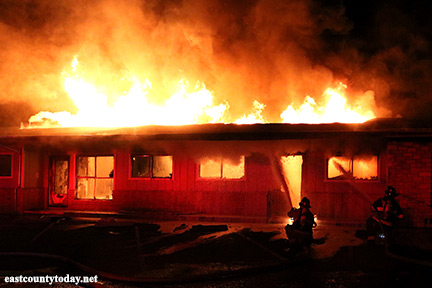For scanner enthusiast who listen to Contra Costa County Fire Radio Traffic, you may have noticed it has been quiet on the radio during major incidents when it comes to structure fire responses—that is because Contra Costa County Fire has made a policy change to move them immediately to tactical channels.
The move came on May 15 when a bulletin went out followed by the policy in place on May 22.
Under the policy (below), all structure fires will be assigned with a command and tactical channel, along with a dedicated dispatcher. The dispatcher’s role will be to conduct a roll call, provide updates to units responding, monitor tactical traffic, and support the assigned incident.
What does this exactly mean to the public who do not have a high-quality scanner?
It means less transparency to the public in real-time. The policy kills status updates in emergency situations because everything will now be handled on Tactical Channels.
What you won’t hear:
- Condition upon arrival reports such as working fire or not.
- Condition updates by firefighters or battalion chiefs
What the public will continue to hear is the initial dispatch, any call for second alarm or alarm thereafter and when the incident being terminated. Everything in the middle, forget it unless you have a scanner programmed with tactical channels—note, most scanners may not even work if rumors are true about Phase II coming sometime in Spring/Summer 2020.
According to Contra Costa County Fire spokesperson Steve Hill, he said there was nothing mysterious about the policy but rather it’s about improving their responses and making it more efficient use of communication in an uber-busy district.
Here is the following Bulletin and policy that went out on May 15 from Assistant Fire Chief Chuck Stark and William Pigeon:
Effective May 22, 2019 at 0800 hours, all Structure Fire responses will be assigned with a command and tactical channel. The command and tactical channel will both be monitored with a dedicated dispatcher on the assigned tactical channel.
This procedure change follows the training that Operations and Communications Center Personnel have received during the past few weeks. The addition of “Fire Attack Mode” will also become effective on the same date.
These updated Structure Fire Dispatch procedures will be a standard for all Agencies served by the Contra Costa County Fire Communications Center.
The Training Division has distributed an assignment on Target Solutions that outlines the new and edited Policies, Procedures, and Information Sheets that support these changes.
All training materials can be accessed via Target Solutions:
File Center-Training-Training Topics- Structure Fire Dispatch and Fire Attack Mode Training
Please contact your Shift Training Captain if you need assistance or have questions related to this Training or accessing the Training Materials.
Here is a look at the Procedure for Structure Fire Dispatch and Communications:
Introduction
The assignment of a command and tactical channel upon dispatch to structure fires will improve communications, Firefighter safety, and keep the dispatch channel clear for new incidents.
Procedure
For structure fires, the Contra Costa County Regional Fire Communications Center (CCRFCC) will provide a dedicated dispatcher on the tactical channel assigned. This dispatcher’s role will be to conduct a roll call, provide updates to units responding, monitor tactical traffic, and support the assigned incident. Initial IC’s and/or Battalion Chiefs may request a dedicated dispatcher for other incident types (complex Rescue’s, Haz Mat’s, MCI’s, etc). Requests for a dedicated dispatcher should be reserved for critical life/safety incidents, as it impacts the resources available in the CCCRFCC.
- Tactical Channel Usage
A. The CCRFCC Dispatcher will begin monitoring assigned tactical channel at the time of assignment.
B. First alarm Captains shall update their MDT and switch their mobile radio to the assigned tactical channel. Portable radios should also be switched to the assigned tactical channel.
C. Captains shall transmit “responding” on the tactical channel assigned. E.g., “E2 responding”. Units “responding” on tactical will not be acknowledged by the dispatcher to save time.
D. Once all companies have responded verbally, the CCRFCC will notify the Battalion Chiefs responding that “roll call” is complete, that all units are responding, and provide an update of the incident. E.g., “Battalion 1 & 2, ConFire, you have all companies responding on Bravo 4 to a reported structure fire. We are receiving multiple calls.”
E. The Battalion Chiefs will acknowledge the message on the tactical.
F. Any unit may suspend the roll call for priority traffic. For example, if a unit has a short response to the scene and needs to transmit a condition report.
G. Additional Units responding on “Working Fire” responses will switch to the tactical. Suppression Units (Engines or Rescues) will announce their response on the tactical.
H. Updates, enroute condition reports, arrival condition reports, and other traffic related to the incident shall be transmitted on the tactical channel.
I. The dedicated dispatcher should be released from the tactical channel as soon as possible.
- Command Channel Usage
A. When the Battalion Chief assumes IC, the command channel should be utilized. The command channel will be monitored by the CCRFCC at time of assignment.
B. Second alarm or greater resources will respond on the command channel. There will be no roll call conducted for additional alarm resources. Units shall contact the IC on command channel upon arrival for assignment.
C. The command channel will be the staging channel for structure fires.
D. The CCCRFCC, Chief Officers, Staging Managers, Safety Officers, and Division/ Group Supervisors will monitor and primarily conduct their radio traffic on the command channel.
E. Additional tactical or support channels can be requested by the IC.


1 comment
This could have been summed up in a single sentence. Buy a $1,000 worth of scanner equipment and you can hear whatever you want from the fire department. No one is hiding anything. You just now have to pay a high price for equipment.
Comments are closed.